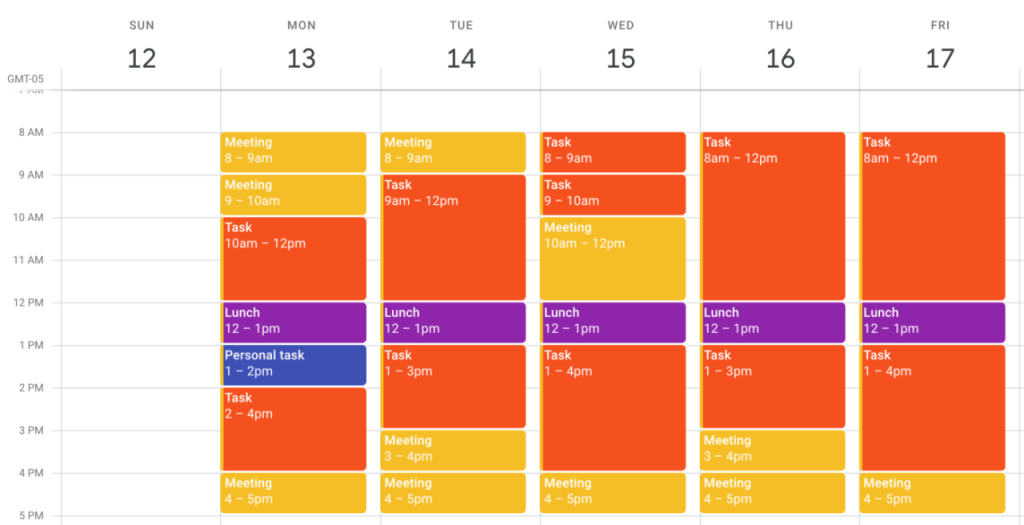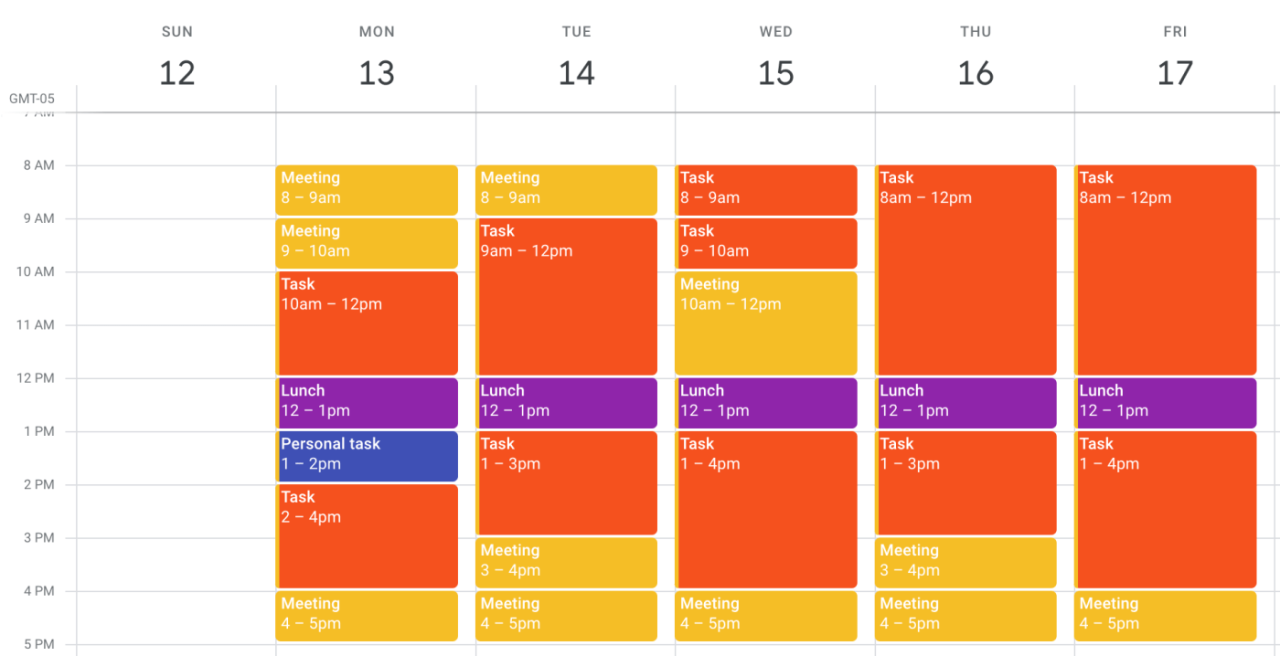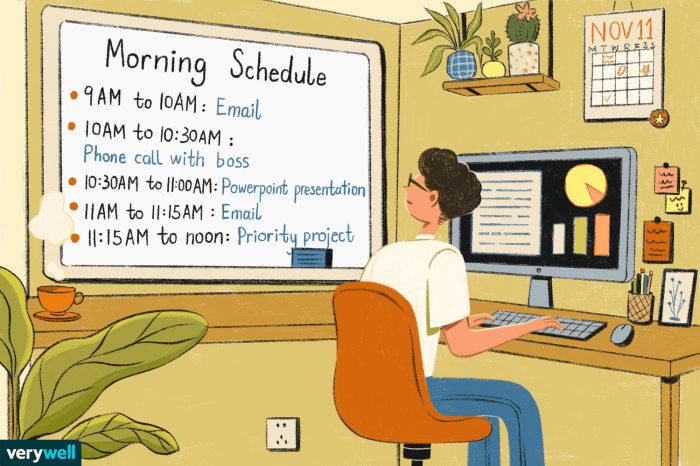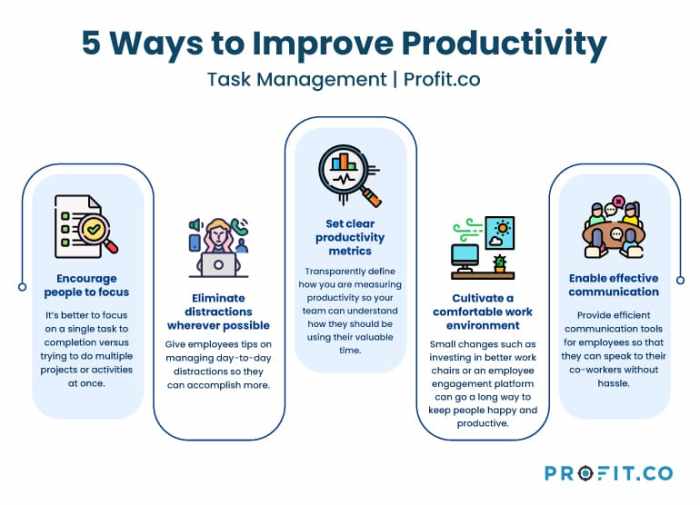
Feeling overwhelmed by your to-do list? Time blocking might be your secret weapon. This strategy involves dividing your day into dedicated blocks of time for specific tasks, transforming you from a chaotic whirlwind into a productivity powerhouse.
Imagine a day where you effortlessly focus on each task, minimizing distractions and achieving more in less time. This is the power of time blocking. It’s not just about managing your time, it’s about mastering it.
Understanding Time Blocking

Time blocking is a powerful productivity technique that involves dividing your day into specific blocks of time and assigning specific tasks or activities to each block. It’s a structured approach to time management that helps you stay organized, focused, and on track to achieve your goals.
Examples of Time Blocking
Time blocking can be applied in various aspects of your life, including work, personal commitments, and leisure activities. Here are some examples:
- Work: You can block out time for specific projects, meetings, email management, and focused work sessions.
- Personal: You can allocate time for exercise, cooking, spending time with loved ones, and personal development activities.
- Leisure: You can schedule blocks for hobbies, reading, relaxation, and other activities that bring you joy.
Benefits of Time Blocking
Time blocking offers several benefits that can significantly improve your productivity and overall well-being.
- Improved Focus: By dedicating specific blocks of time to certain tasks, you eliminate distractions and can concentrate on completing them effectively.
- Reduced Stress: Having a structured schedule helps you feel more in control of your time, reducing anxiety and overwhelm.
- Better Time Management: Time blocking helps you prioritize tasks, allocate time wisely, and avoid procrastination.
- Increased Accountability: When you commit to a specific schedule, you’re more likely to stick to it and achieve your goals.
- Enhanced Productivity: By minimizing distractions and maximizing focus, time blocking allows you to get more done in less time.
Creating a Time Blocking Schedule
Creating a time blocking schedule is like crafting a roadmap for your day, helping you stay focused and productive. It involves breaking down your day into specific time blocks dedicated to different tasks.
Identifying Priorities and Allocating Time
Before diving into the schedule, understanding your priorities is essential.
- Prioritize tasks based on their importance and urgency. This can be done using the Eisenhower Matrix, which categorizes tasks into four quadrants: Urgent and Important, Important but Not Urgent, Urgent but Not Important, and Not Urgent and Not Important.
- Allocate time to high-priority tasks first. This ensures you focus on the most critical activities that drive your goals.
- Consider your energy levels. Schedule demanding tasks during your peak productivity hours and lighter tasks when your energy is lower.
Scheduling Flexible Blocks
While time blocking provides structure, unexpected tasks or interruptions can arise.
- Include buffer time. This flexibility allows you to accommodate unforeseen events without disrupting your entire schedule.
- Set aside time for “catch-up” tasks. This block can be used to address any tasks that were not completed within their allocated time.
- Be adaptable. If you find your schedule isn’t working, don’t be afraid to adjust it. Time blocking is a dynamic process, and your schedule should evolve with your needs.
Implementing Time Blocking Effectively
You’ve created a time-blocking schedule, but how do you stick to it? Implementing time blocking effectively requires strategies to stay on track, realistic expectations, and techniques to maximize focus.
Staying On Track with Your Schedule
Sticking to your time-blocking schedule is crucial for maximizing its benefits. Here are some strategies to help you stay on track:
- Visual Reminders: Use a physical or digital calendar to visually represent your schedule. This helps you see your allocated time blocks and stay accountable.
- Set Reminders: Utilize phone alarms or calendar notifications to remind yourself of upcoming time blocks. This helps you transition smoothly between tasks.
- Track Your Progress: Regularly review your schedule and track your progress. This helps you identify areas where you’re struggling to stay on track and make necessary adjustments.
Setting Realistic Expectations
Time blocking is not a magic bullet. It’s essential to set realistic expectations and be prepared to adjust your schedule as needed.
- Don’t Overcommit: Avoid scheduling too many tasks in a single day. It’s better to start with a few essential tasks and gradually increase your workload as you become more comfortable.
- Allow for Flexibility: Unexpected events or tasks may arise. Build in some buffer time between blocks to accommodate these unforeseen circumstances.
- Be Kind to Yourself: It’s okay to deviate from your schedule occasionally. Don’t be too hard on yourself if you miss a block or need to adjust your plan. The key is to learn from these experiences and make necessary adjustments.
Minimizing Distractions and Maximizing Focus
Distractions are the enemy of productivity. Employing techniques to minimize distractions and maximize focus during your blocked time is crucial.
- Create a Dedicated Workspace: Designate a specific area for work that is free from distractions. This could be a home office, a quiet corner in your living room, or a local coffee shop.
- Silence Notifications: Turn off all non-essential notifications on your phone, computer, and other devices. This helps you avoid being pulled away from your tasks.
- Use a Timer: Set a timer for each time block and focus solely on the task at hand during that time. This helps you stay focused and avoid procrastination.
- Practice Mindfulness: Incorporate mindfulness techniques like deep breathing or meditation to clear your mind and enhance focus.
Productivity Tools and Resources
Time blocking, while a powerful productivity technique, is most effective when paired with the right tools and resources. These can help streamline your scheduling, enhance your focus, and optimize your overall productivity.
Time Blocking Tools and Apps
The following table showcases popular time blocking tools and apps, highlighting their features and benefits:
| Tool/App | Features | Benefits |
|---|---|---|
| Google Calendar | Event scheduling, reminders, color-coding, integration with other Google services | Free, intuitive, easy to use, excellent integration with other productivity tools |
| Todoist | Task management, project planning, time tracking, recurring tasks, collaboration features | Excellent task management, intuitive interface, flexible and customizable, supports time blocking |
| Asana | Project management, task assignment, communication, deadlines, progress tracking | Powerful project management features, team collaboration tools, integrates with time blocking apps |
| Focus To-Do | Pomodoro timer, time blocking, task prioritization, distraction blocking | Focus-oriented, time blocking features, distraction-free environment, promotes efficient work sessions |
| Clockify | Time tracking, project management, reports, team collaboration | Detailed time tracking, insightful reports, supports time blocking for accurate time allocation |
Productivity Resources
Beyond tools, numerous resources can deepen your understanding of time blocking and productivity:
-
Books:
- “Getting Things Done” by David Allen: A classic guide to productivity, emphasizing task management and prioritization.
- “Deep Work” by Cal Newport: Explores the power of focused, uninterrupted work sessions for achieving high-quality results.
- “The 4-Hour Workweek” by Timothy Ferriss: Offers strategies for optimizing time, automating tasks, and achieving more in less time.
- Articles:
- “The Time Blocking Method: How to Schedule Your Day for Maximum Productivity” by Forbes: A comprehensive guide to implementing time blocking for enhanced productivity.
- “Time Blocking: The Secret to Productivity That Works” by Lifehack: Discusses the benefits and strategies for effective time blocking.
- “Time Blocking: A Simple Strategy to Boost Your Productivity” by The Muse: A practical guide to implementing time blocking in your daily routine.
- Websites:
- Time Management Ninja: A website dedicated to time management techniques, including time blocking, with articles, resources, and tools.
- Productivityist: Offers a wealth of information on productivity, including time blocking strategies, with articles, podcasts, and courses.
- Lifehacker: A popular website for productivity tips, including time blocking techniques, with articles, guides, and resources.
Productivity Beyond Time Blocking

Time blocking is a powerful productivity technique, but it’s not a magic bullet. To maximize your effectiveness, it’s crucial to integrate time blocking with other productivity strategies.
Combining Time Blocking with Other Techniques
By combining time blocking with other productivity techniques, you can create a well-rounded system that addresses various aspects of your workflow. Here are some effective combinations:
- Time Blocking + Pomodoro Technique: Break down your time blocks into focused work sessions (e.g., 25 minutes) interspersed with short breaks (e.g., 5 minutes). This method helps maintain focus and prevents burnout.
- Time Blocking + Eisenhower Matrix: Prioritize tasks within your time blocks based on their urgency and importance. This ensures you focus on the most impactful activities first.
- Time Blocking + Getting Things Done (GTD): Use time blocking to allocate time for specific tasks captured in your GTD system. This streamlines task execution and prevents overwhelm.
- Time Blocking + Mindfulness: Incorporate short mindfulness practices into your time blocks to enhance focus and reduce stress. This can improve your overall productivity and well-being.
Comparing Time Blocking with Other Methods
Time blocking offers distinct advantages over other productivity methods:
- Time Blocking vs. To-Do Lists: Time blocking provides a structured framework for task execution, unlike to-do lists, which can be overwhelming and lack a clear timeline.
- Time Blocking vs. The Pareto Principle (80/20 Rule): Time blocking helps allocate time for both high-impact tasks (20%) and necessary but less impactful tasks (80%). The Pareto Principle focuses primarily on identifying and prioritizing the high-impact tasks.
- Time Blocking vs. The Pomodoro Technique: Time blocking provides a broader time management framework, while the Pomodoro Technique focuses on focused work sessions interspersed with breaks. They complement each other.
Common Productivity Pitfalls and Solutions
Even with time blocking, productivity can be hindered by various pitfalls. Understanding these pitfalls and implementing solutions can significantly improve your results:
- Procrastination: Set realistic deadlines within your time blocks and break down large tasks into smaller, manageable chunks. Use timeboxing to create a sense of urgency and accountability.
- Distractions: Minimize distractions by using tools like website blockers, noise-canceling headphones, and creating a dedicated workspace. Incorporate short breaks to prevent burnout and refresh your focus.
- Overcommitting: Be mindful of your capacity and avoid overbooking your schedule. Prioritize tasks and learn to say no to non-essential commitments.
- Lack of Flexibility: Allow for flexibility in your schedule to accommodate unexpected events or changes in priorities. Adapt your time blocks as needed and avoid rigid adherence.
- Lack of Evaluation: Regularly evaluate your time blocking strategy to identify areas for improvement. Track your progress, adjust your approach, and optimize your workflow based on your experiences.
By embracing time blocking, you’ll unlock a world of productivity, leaving behind the days of endless to-do lists and feeling overwhelmed. You’ll gain control of your time, reduce stress, and achieve more than you ever thought possible. It’s time to take charge of your day and unlock your full potential.
Helpful Answers
Is time blocking suitable for everyone?
While time blocking can be incredibly effective, it’s not a one-size-fits-all solution. Some individuals may find it restrictive or difficult to adapt to. It’s important to experiment and find what works best for you.
How do I handle unexpected interruptions?
Flexibility is key. Incorporate buffer time into your schedule to accommodate unexpected interruptions. If a task takes longer than anticipated, adjust your schedule accordingly.
What if I don’t stick to my time blocking schedule?
Don’t be discouraged if you don’t follow your schedule perfectly at first. It takes practice to master time blocking. Be kind to yourself and adjust your approach as needed.




